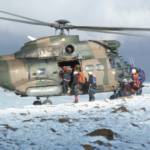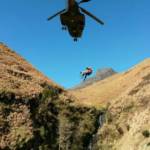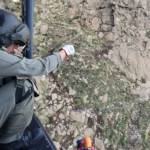So, you are out in the mountains and something bad has happened. A call has been made for help and after some time, you are informed by the rescue team leader that a heli-borne operation is getting underway……what next?
First and foremost, as I have said in other posts, things usually take time. There are a few places and situations where once it is decided that a helicopter is the best option, it might lift off in a few minutes and be on scene soon afterwards. But the majority of the time, however, it could be an hour or even several hours. So sit tight, it’s a long wait!
If the South African Air Force is being used, as in many cases, every time a rescue helicopter lifts off, there is long paper trail of requests, orders, authorisations, signals and call signs before the rotors actually start to turn. One reason for this is when a flight is undertaken, it is usually at tax payers expense and there had better be a good reason for it. The cost per hour for an Oryx helicopter is an eye-watering amount of cash.
As a hiker or climber waiting for a helicopter arrival, you need to do the following;
If it is a patient going to hospital, gather their ID , wallet, medical aid card etc. and make sure it goes with them. Depending on the weight considerations and space on the aircraft, sometimes a friend or family member can go with to hospital.
The down wash of a helicopter is huge, so pack away all tents, sleeping-bags, mattresses, remove your hats and caps, long before it arrives on scene. As a result of down wash, there are several rather expensive tents in various gullies of the Drakensberg, including a valid French passport lying on Rwanqa peak!
Loose items are a huge hazard to a helicopter, as they can get blown sideways or up a slope, then into the air and back down in the rotors.
Contrary to common belief, a hiking party even in bright colours, are not easily seen from the air. From an aircraft, people become tiny dots on a vast landscape. People sitting in slight shadows or in rocks, can simply go unnoticed.
Two good ways to show your position is to use the flash of a cell phone or a camera, which can be seen for 2-3 km, especially in low light or when in a shadowy valley. Another option, if safe to do so, is make some thick smoke by burning a few leaves. This also has the advantage of giving wind direction to the pilot. Once seen by the air crew they will usually flash their lights.
When reporting your position to a rescue team, again there are some misunderstandings of what is needed. There is a belief that what a rescue team needs are co-ordinates and are often given from a GPS in decimal degrees or decimal minutes. This idea might be OK if you are floating in a dingy in the middle of the Indian Ocean, but in the mountains, a verbal description is number one. The co-ordinates are a secondary affirmation of your position. For example, “We are approximately 400m upstream of Tseke Hut, in the riverbed”, is far more information than a bunch of numbers. In addition, give the co-ordinates in good old standard degrees minutes and seconds , even just read off a map.
Pin point accuracy of the co-ordinates is not needed. A rescue helicopter may have the co-ordinates entered into the navigation system for the main approach flight, but closer in it is guided by someone in the back who knows the area, with a map in hand saying “go up this valley, over that ridge, look for the group in that area”. A mountain rescue helicopter does not fly in with a pilot watching their position on a GPS, then slowly coming to a hover and looking down and finding the rescue scene. The pilot gets to the general area and is then directed by human brains and eyes.
When the aircraft approaches, and if it is in marginal conditions, it will usually stand off in clear air and a power check will done, before committing to the landing or to hover. When a helicopter comes in close to a mountain, with less and less lift due to the slowing of forward speed, they enter what is called, ‘dead man’s curve”. This is the close proximity to the ground and in the event of an emergency, does not allow them to put the nose down, get forward speed and escape the situation. Therefore as a person waiting on the ground, try to position yourself in such a way that you are either on flat, open ground or on a ridge or buttress, where there is clear air beyond, that an aircraft can escape to in an emergency. The emergency might be simply running out of power to stay in the air at high altitude. Narrow valleys or gullies are a particular hazard for helicopters.
Once the aircraft has landed or if being hoisted out, simply stay calm and follow the directions given by the crew or rescue team.
I hope you never have to do any of this!
Next we talk about what can be done when a helicopter us not being used and patient carry-outs with man power.
For full courses on how to handle rescues, searches, navigation, group leadership contact: gavin@peakhigh.co.za or www.peakhigh.co.za


